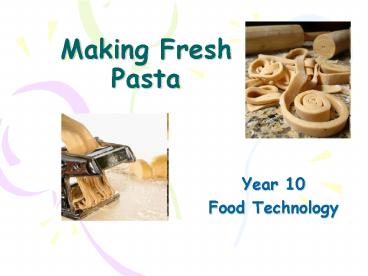Making Fresh Pasta PowerPoint PPT Presentation
Title: Making Fresh Pasta
1
Making Fresh Pasta
- Year 10
- Food Technology
2
Lesson Objective
- Tasks
- Prepare yourselves to work wash your hands,
take off jewellery, take off outside coats,
remove nail varnish and tie back hair (if
appropriate). - Now follow the next few slides
- To make a batch of fresh pasta ready to turn
into a pasta main meal
Success Criteria To plan and organise your work
space To use the recipe method cards To produce
a batch of high quality pasta using authentic
ingredients To work in a hygienic and safe way
throughout the practical lesson
3
Tasks
- For the recipe, let's keep things simple and make
enough to construct a good sized lasagne for four
people. You will need - Two large eggs as fresh as possible
- Around 120 g of unbleached flour
- Place the flour on a clean kitchen surface and
make a well in the centre using your fingers. - Break the eggs into this well and from the
outside in begin folding the flour into the eggs,
using your fingers to break and evenly distribute
the yolk and white. Alternatively you could whisk
the eggs lightly before adding to the flour. - Bind the mixture together until it becomes a
single mass. If the mixture continues to feel a
little wet, add a touch more flour. - Then knead it - pulling, stretching and pushing
down with the heel of your hand - until the ball
of dough is silky smooth to the touch. - Wrap it in cling film and put in the fridge for
15 minutes. - Clean the kitchen surface, flour it again and
using a roller, also lightly floured, begin
flattening out the dough until it is very thin.
If the area you are working on is very tight,
split the dough into two. - Then simply cut out the dough into rectangular
pieces and you are ready to construct your
lasagne.
4
About fresh pasta
- Fresh could be said to be more desirable in that
it is made with eggs rather than water, and
provides a different experience in terms of
texture in the mouth, but it is designed for and
only works with certain dishes. - For example, that aforementioned softer texture
may be fine with a richer meat ragu, but it lacks
that certain bite, known to the Italians as al
dente, that makes the dried variety a better
complement to sauces with less fat content.
5
AfL
- How well did you cope during the making stages of
the pasta, did you need any help from the
teacher? - Did you produce a batch of high quality pasta
suitable for the correct dish? - Did you clean up and wash everything in an
independent way - Did you need to follow my task list, or did you
remember how to make the recipe from the
demonstration I showed you?
6
Conchigliette
Spaghetti
Fusilli
Shaped pastas such as fusilli (twists) and
conchiglle (shells) go well with all sort of
sauces, but especially those with texture
(lumps!). If you think about it those lumps of
meat, vegetable, or bean are going to get caught
up in the crevices and twists. (Which is a GOOD
thing!)
Short, tubular pastaslike rigatoni, penne or
cavatappi go well with sauces that are thick or
chunky. Keep the size of the ingredients in mind
tiny macaroni won't hold a chickpea, while
rigatoni may feel too large for a simple tomato
sauce, where penne would work better. Ridged
pastas provide even more texture for sauces to
cling to.
Cavatappi
Penne

